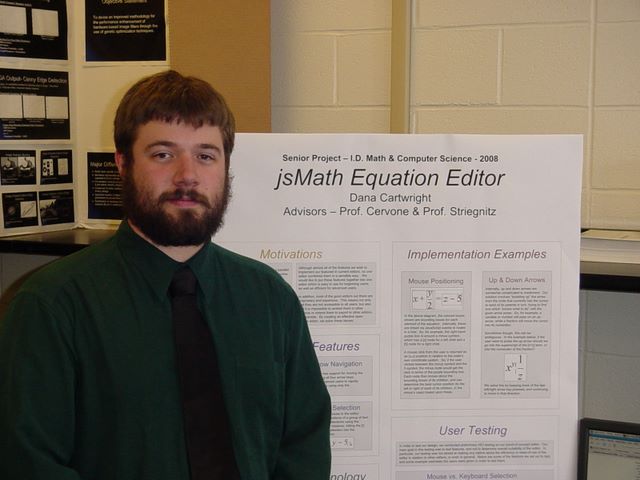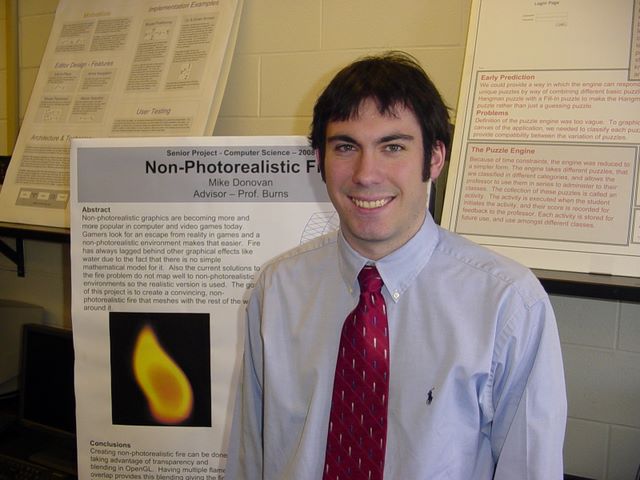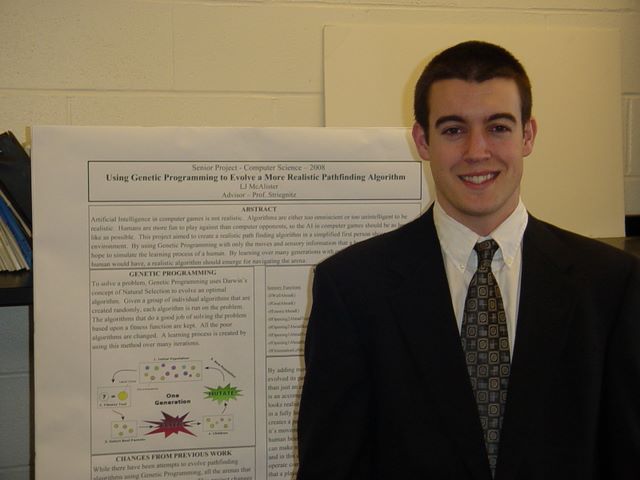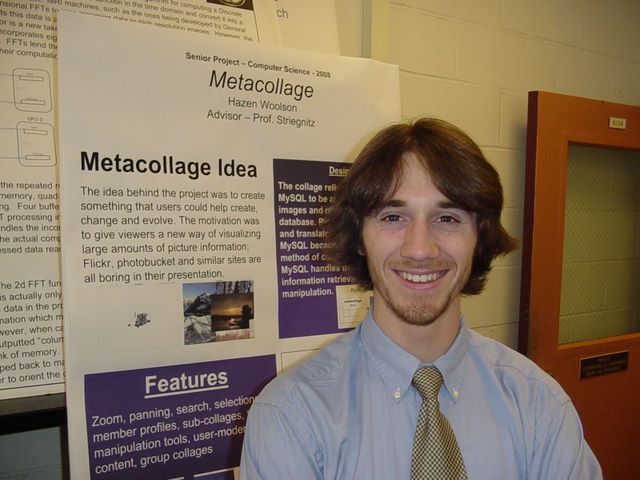| Click on a student picture for a larger view. |

Benjamin AtkinsAdvisor: Prof. Almstead and Prof. OrellanaColor Pickr
Many people struggle with picking colors for designs and projects. People often have an idea of one color they want to base their theme around, but do not always have a great sense of which colors go well together. Although there are currently already several sites on the web that allow users to submit and post their favorite color schemes most of them do not have tools that help you to generate your own. Most of the tools on the web that are geared to help people generate their own color schemes, are hard to find and underdeveloped. My program gives users the option to start by picking their own generation scheme from an assortment of styles (tint, shade, complimentary, my own algorithm, and possibly a few more to be integrated soon), and then customize it by changing some of the individual colors that make up the generated palette.
|

Nick BaloghAdvisor: Prof. BurnsTouching is Good:A Study of Game Design for the Nintendo DS
The Nintendo DS is like nothing else the industry has seen before. As a result, game designers had to rethink the way they designed games for the hand held market. The best games for the DS heavily incorporate the use of the stylus with the touch screen and utilize the dual screens of the DS effectively. This project will give insight to why it is hard to design a good game for the DS and in turn will design and develop a game with these ”good game” principles as a guide.
|

Dana E. CartwrightAdvisor: Prof. Cervone and Prof. StriegnitzjsMath Editor - Mathematical Equation Editor Design
In order to typeset mathematics on computers, and therefore communicate ideas in science, mathematics, and other related fields across the internet, as well as other mediums, it is necessary to have a specialized piece of software to convert simple keyboard entry into complex equations. This software is referred to as an equation editor. While many equation editors are available today, significant usability issues exist in all of them. My project involved designing a specification for a new editor from the ground up with a selection of the best of the features exhibited in current editors. A web-based proof-of-concept editor was then created from this specification, and user testing conducted on it to determine which features in the editor were successful, and which needed more improvement. This presentation will outline some conclusions about editor design drawn from the project, as well as present the current editor and highlight some of its more interesting features.
|

Mike DonovanAdvisor: Prof. BurnsNon-Photorealistic Fire
Non-photorealistic graphics are becoming more and more popular in computer and video games today. Gamers look for an escape from reality in games and a non-photorealistic environment makes that easier. Fire has always lagged behind other graphical effects like water due to the fact that there is no simple mathematical model for it. Also, compared to water fire plays a smaller role in games. However, seeing a bad implementation of fire can throw off the whole look and feel of the game. The current solutions to the fire problem do not map well to non-photorealistic environments so the realistic version is used. The goal of this project is to create a convincing, non-photorealistic fire that meshes with the rest of the world around it.
|

Leonard F. McAlister Jr.Advisor: Prof. StriegnitzUsing Genetic Programming to Evolve a More Realistic Pathfinding Algorithm
Artificial Intelligence in computer games is not realistic. Algorithms are either too omniscient or too unintelligent to be realistic. Humans are more fun to play against than computer opponents, so the AI in computer games should be as human-like as possible. This project aimed to create a realistic path finding algorithm in a simplified first person shooter environment. By using Genetic Programming with only the moves and sensory information that a human would have, we hope to simulate the learning process of a human. By learning over many generations with only the same options that a human would have, a realistic algorithm should emerge for navigating the arena.
|
Sam F. LangeAdvisor: Prof. BurnsAttacking the Tor Network
Although almost every communication done through the World Wide Web is encrypted, in this day and age that does not necessarily guarantee that the packets being sent are secure. Attackers have any number of tools at their disposal, such as statistical analysis, to glean the information that one had assumed to be kept a secret from prying eyes. Because of this, Tor was developed to try to protect one’s anonymity when browsing web pages. The goal of this project was to use a certain type of statistical analysis, called a fingerprinting attack, to attempt to break down the defenses Tor puts in place.
|

Kenneth H. WoolsonAdvisor: Kristina StriegnitzMetacollage
Many online sites, like flickr or picasa, offer free image hosting to users, but all present their pictures in very few standard ways. Metacollage is a project that offers a novel way for users to share their images on the web. Users can upload images and place them on a shared infinite canvas, thereby creating a constantly changing collage. They can explore this image landscape through a variety of tools that allow them to move around, zoom in and out, and retrieve information about individual pictures. During this display I will be presenting the development process, ideas and topics surrounding my project, as well as allowing people to use the site.
|
This report generated by script ./write.project.sections - May 23, 2008
Address questions or comments to spallhol@union.edu